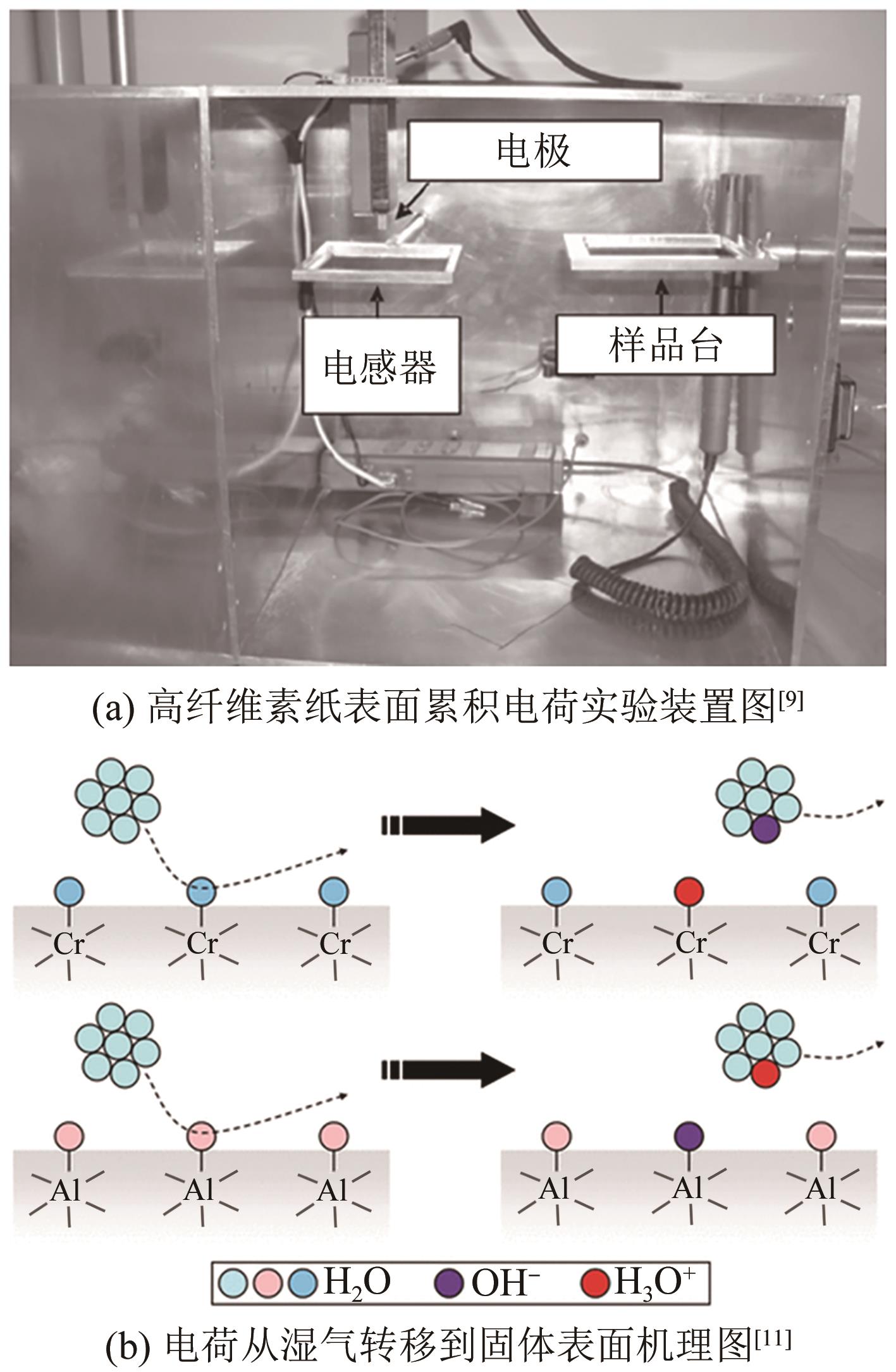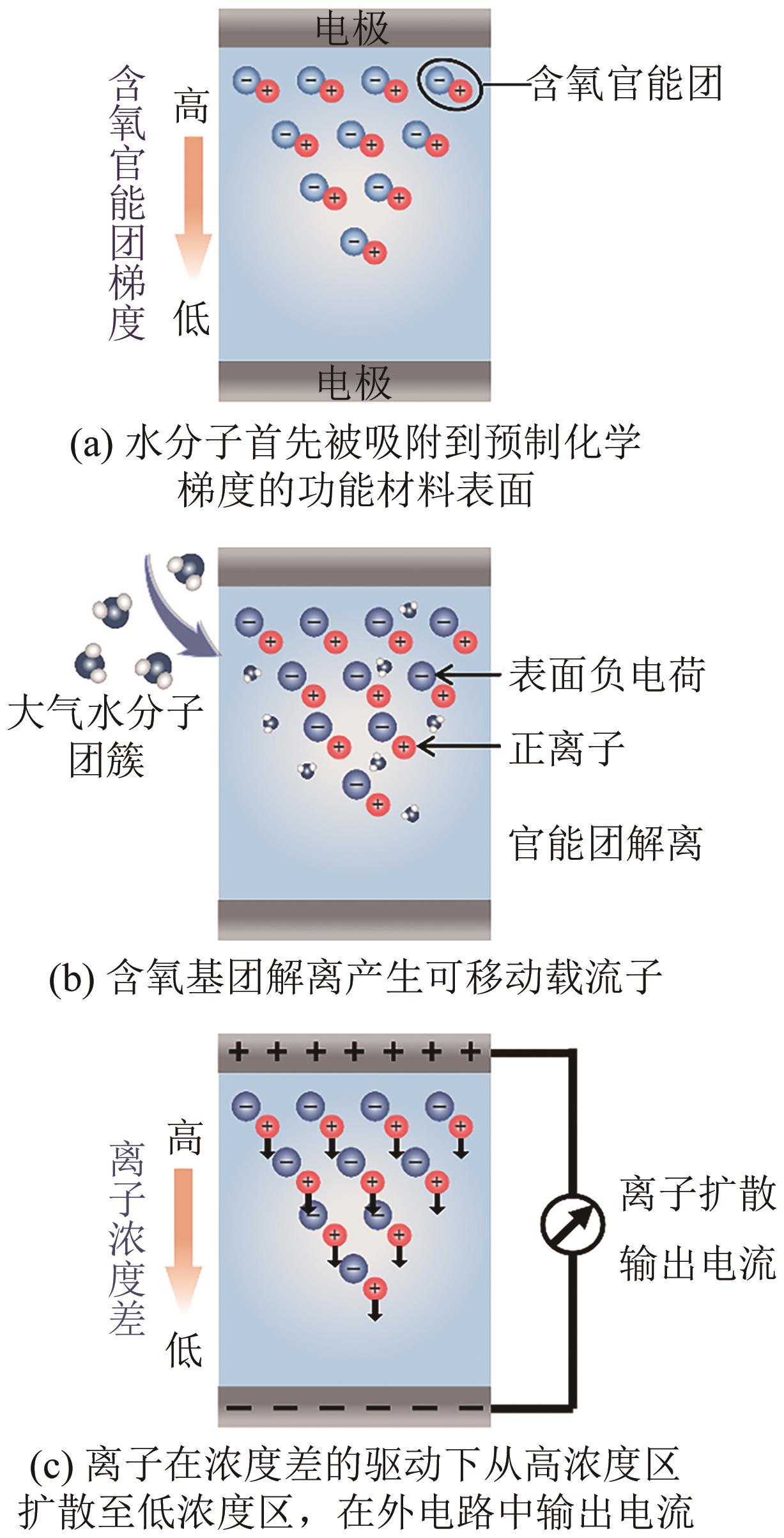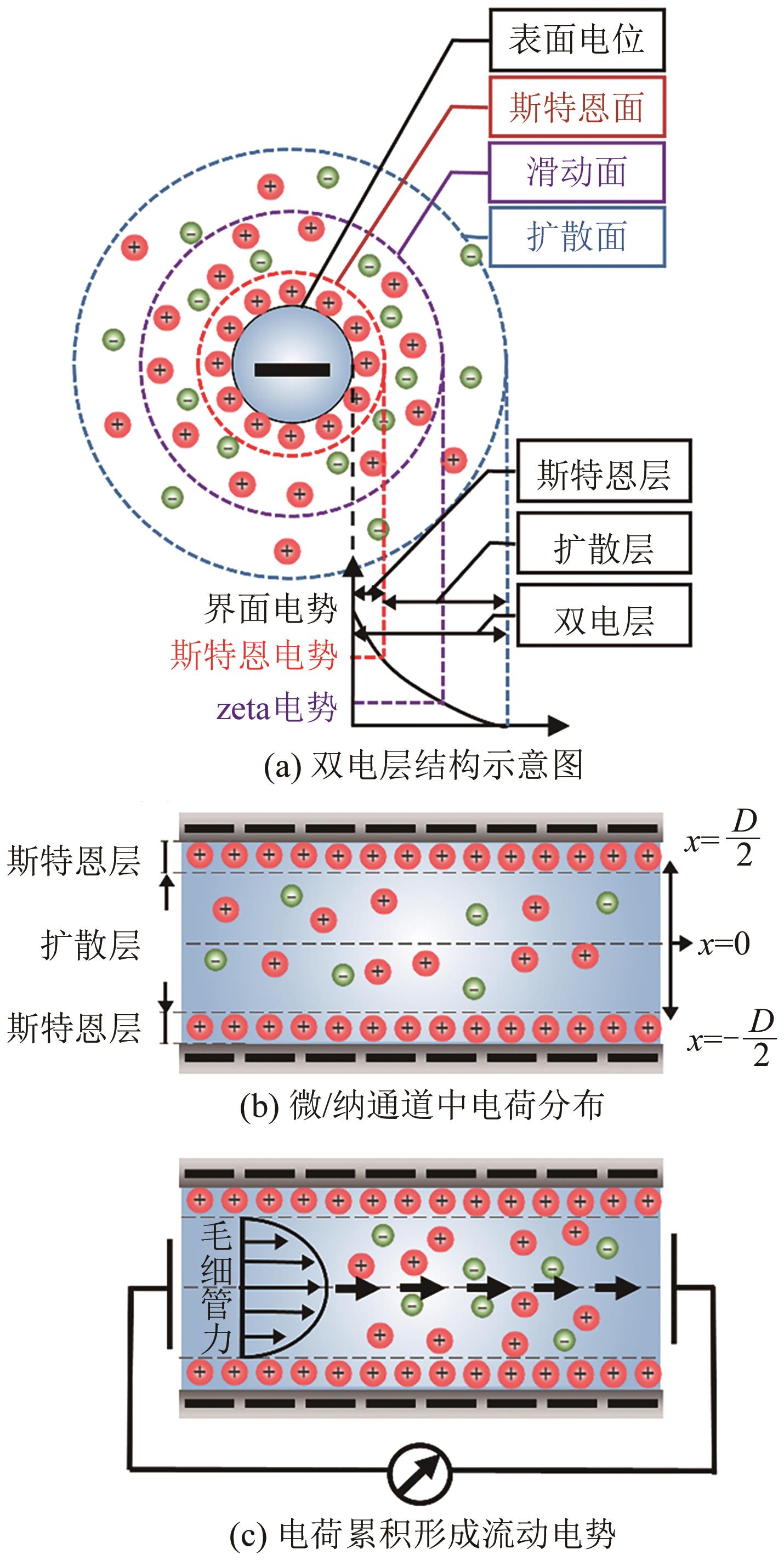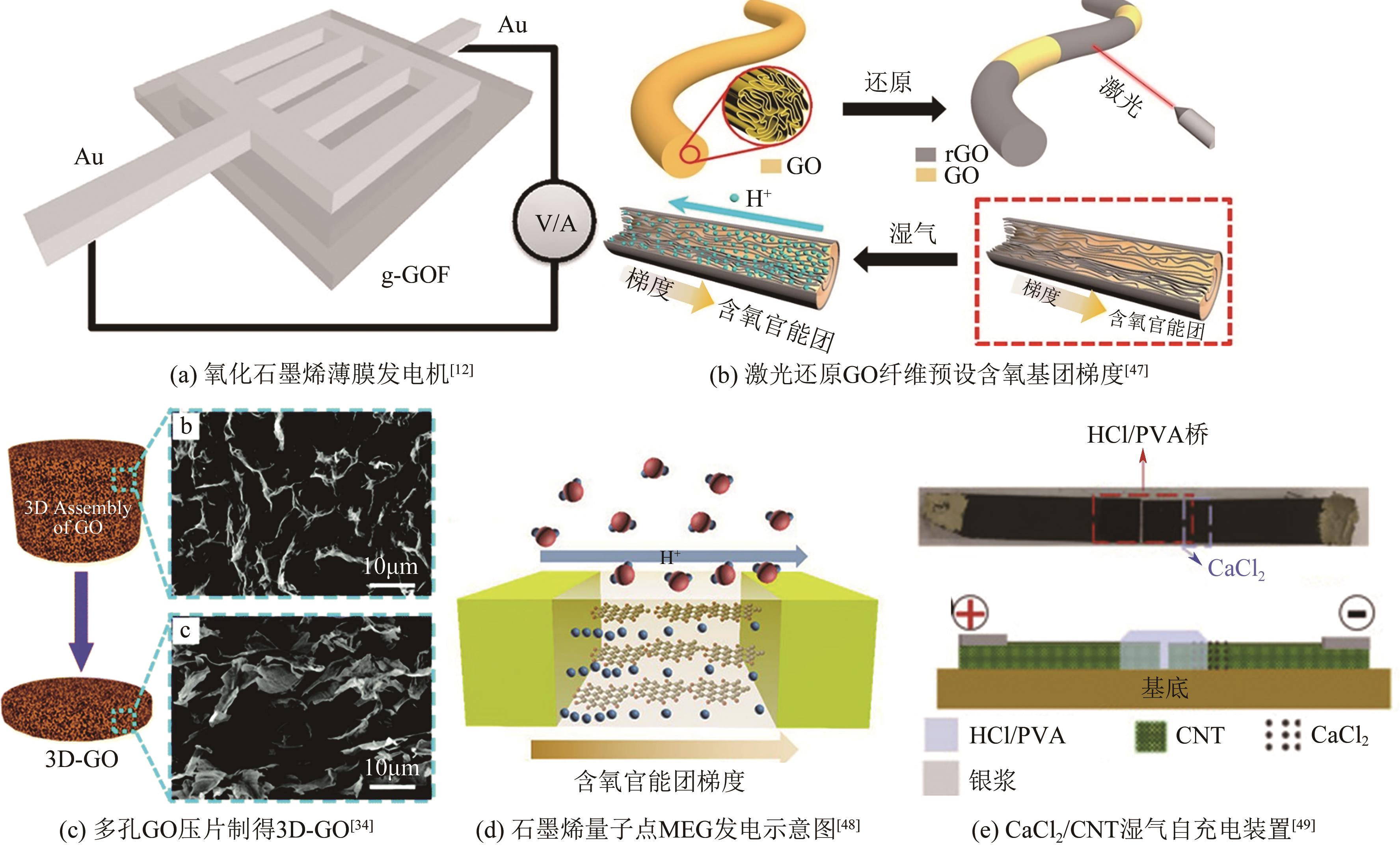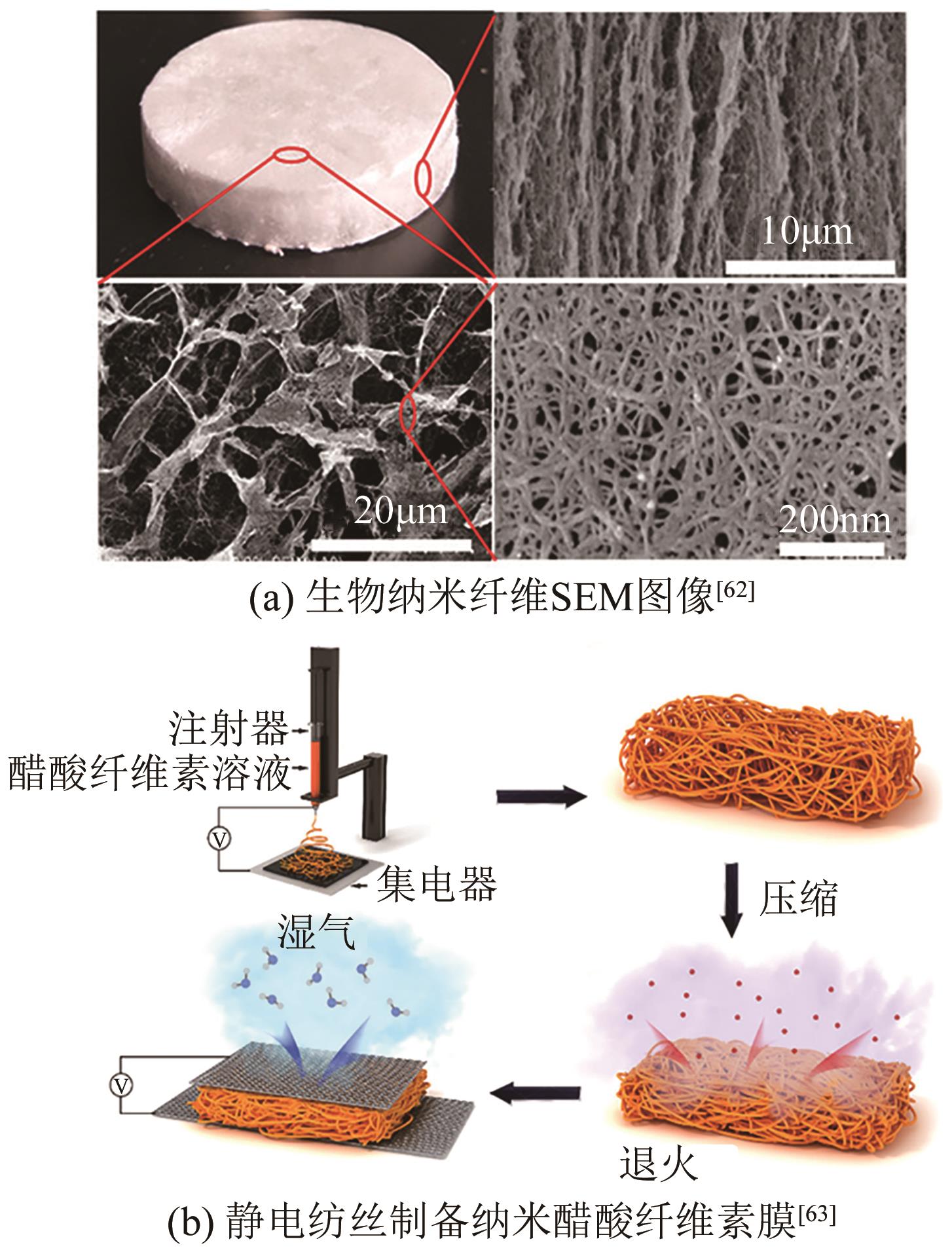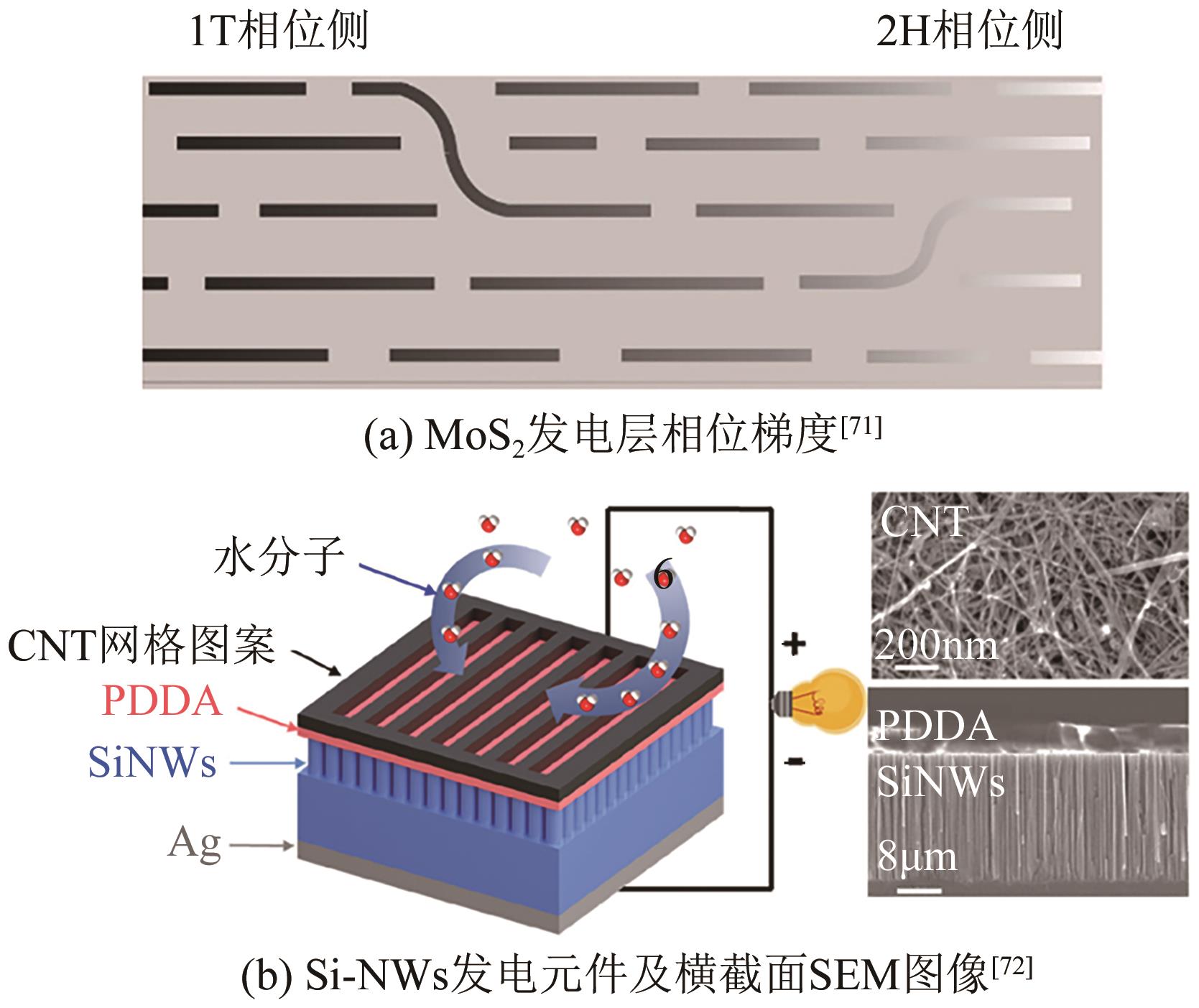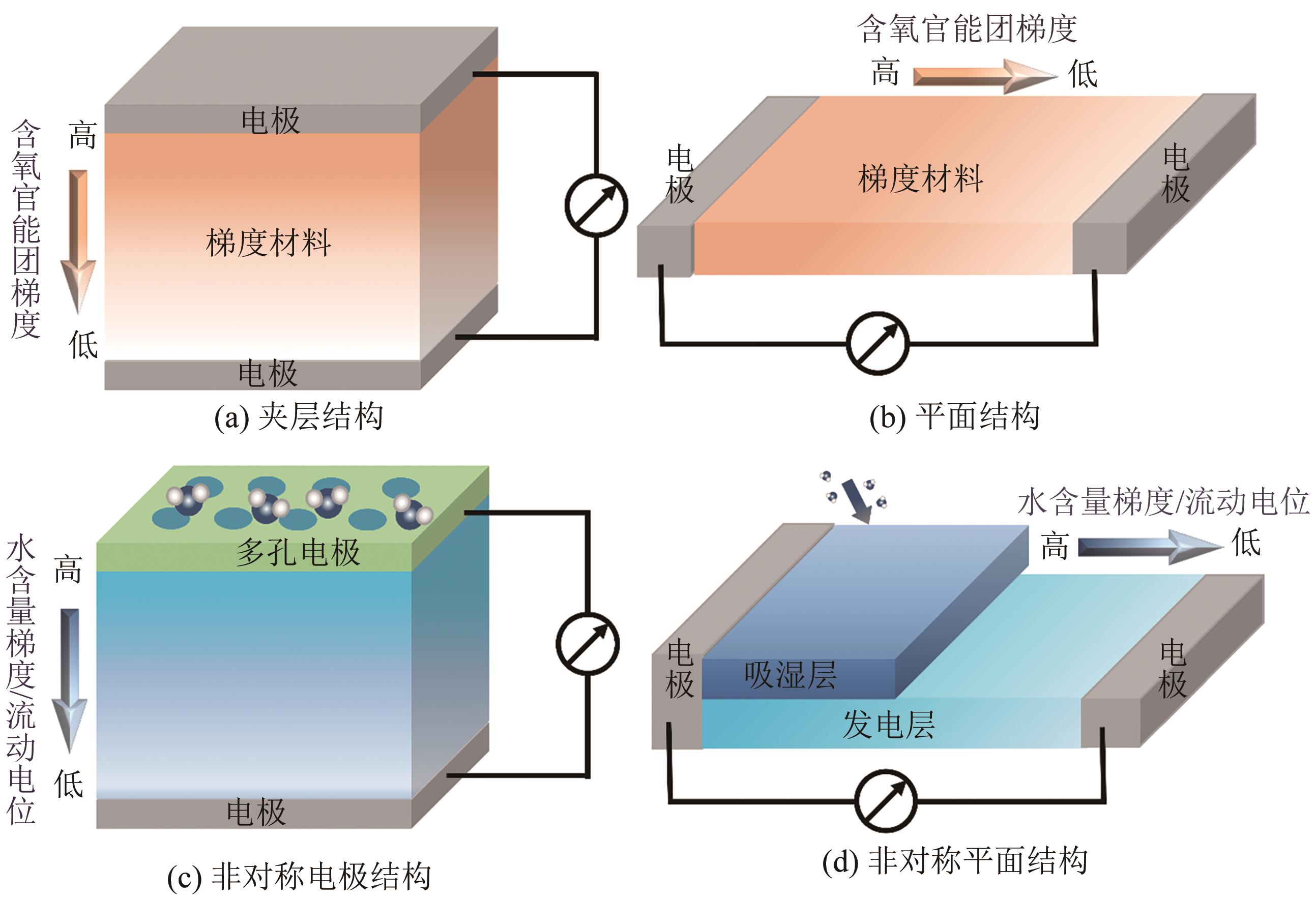化工进展 ›› 2024, Vol. 43 ›› Issue (8): 4490-4505.DOI: 10.16085/j.issn.1000-6613.2023-1225
• 材料科学与技术 • 上一篇
湿气发电技术研究进展
马广鑫1,2( ), 李伟曼1(
), 李伟曼1( ), 周欣1,2, 陈运法1,3(
), 周欣1,2, 陈运法1,3( )
)
- 1.中国科学院过程工程研究所多相复杂系统国家重点实验室,北京 100190
2.中国科学院大学化学工程学院,北京 100049
3.中国科学院大学材料科学与光电技术学院,北京 100049
-
收稿日期:2023-07-18修回日期:2023-08-15出版日期:2024-08-15发布日期:2024-09-02 -
通讯作者:李伟曼,陈运法 -
作者简介:马广鑫(1999—),男,硕士研究生,研究方向为复合吸湿材料。E-mail:maguangxin21@mails.ucas.ac.cn。 -
基金资助:国家重点研发计划重点专项(2022YFC3702800)
Progress of moisture generation technology
MA Guangxin1,2( ), LI Weiman1(
), LI Weiman1( ), ZHOU Xin1,2, CHEN Yunfa1,3(
), ZHOU Xin1,2, CHEN Yunfa1,3( )
)
- 1.State Key Laboratory of Multiphase Complex Systems, Institute of Process Engineering, Chinese Academy of Sciences, Beijing 100190, China
2.School of Chemical Engineering, University of Chinese Academy of Sciences, Beijing 100049, China
3.School of Materials Science and Optoelec-tronic Technology, University of Chinese Academy of Sciences, Beijing 100049, China
-
Received:2023-07-18Revised:2023-08-15Online:2024-08-15Published:2024-09-02 -
Contact:LI Weiman, CHEN Yunfa
摘要:
环境中蕴含着大量的低品位能,利用这种绿色能源开发离网分散式发电系统是补充日常用电的有效途径之一。湿气发电技术是一种利用功能材料与湿气相互作用从中收集能量的技术,近年来受到广泛关注和研究。本文回顾湿气发电技术发展历程,从湿气与发电材料的相互作用原理出发,汇总讨论了目前湿气发电机理的主流解释,包括离子扩散和流动电位等,并介绍了相关的验证工作;整合分析了吸湿发电层材料及其优势与不足,总结归纳了湿气发电机的结构及潜在应用领域;随后阐述了提高湿气发电机能量转换效率和输出功率的方法;最后,对湿气发电技术面临的主要挑战,提出了一些建议以解决存在的问题。湿气发电技术的不断发展将为绿色能源领域带来新的可能性,并推动离网分散式发电系统的可持续发展。
中图分类号:
引用本文
马广鑫, 李伟曼, 周欣, 陈运法. 湿气发电技术研究进展[J]. 化工进展, 2024, 43(8): 4490-4505.
MA Guangxin, LI Weiman, ZHOU Xin, CHEN Yunfa. Progress of moisture generation technology[J]. Chemical Industry and Engineering Progress, 2024, 43(8): 4490-4505.
| 项目 | 离子扩散 | 流动电位 |
|---|---|---|
| 能量转换 | 化学能→电能 | 其他能量→机械能→电能 |
| 机理类型 | 化学变化 | 物理变化 |
| 作用界面 | 气-液-固 | 液-固 |
| 材料维度 | 3D | 2D |
| 发电结构 | 梯度结构 | 微/纳通道结构 |
| 输出电流 | 交流电 | 直流电 |
| 输出方式 | 间歇性 | 连续性 |
| 发电过程 | ①材料吸收水团簇; ②形成移动载流子梯度; ③离子扩散生电 | ①液-固界面作用产生EDL; ②外力驱动下液体流动; ③反离子沿液体运动方向移动 |
表 1 离子扩散和流动电位对比
| 项目 | 离子扩散 | 流动电位 |
|---|---|---|
| 能量转换 | 化学能→电能 | 其他能量→机械能→电能 |
| 机理类型 | 化学变化 | 物理变化 |
| 作用界面 | 气-液-固 | 液-固 |
| 材料维度 | 3D | 2D |
| 发电结构 | 梯度结构 | 微/纳通道结构 |
| 输出电流 | 交流电 | 直流电 |
| 输出方式 | 间歇性 | 连续性 |
| 发电过程 | ①材料吸收水团簇; ②形成移动载流子梯度; ③离子扩散生电 | ①液-固界面作用产生EDL; ②外力驱动下液体流动; ③反离子沿液体运动方向移动 |
| 发电材料 | 电极 | 结构 | 梯度来源/流动电位 | 湿度/% | 输出电压/V | 电流密度/mA·cm-2 | 供电时长 | 参考文献 |
|---|---|---|---|---|---|---|---|---|
| GQDs | Au/Au | 平面 | 官能团 | 70 | 0.27 | 27.7 | 周期供电 | [ |
| GO | rGO/rGO | 纤维 | 官能团 | 65 | 0.4 | 1 | 周期供电 | [ |
| GOF | Au/Au | 夹层 | 官能团 | 30 | 0.02 | 5×10-3 | 周期供电 | [ |
| g-3D-GO | Al/Al | 夹层 | 官能团 | 75 | 0.26 | 3.2 | 周期供电 | [ |
| GO-g-rGO | Ag/Au | 平面 | 官能团 | 85 | 1.5 | 1×10-4 | 周期供电 | [ |
| GO | Ag/Ag | 同轴光纤 | 官能团 | 70 | 0.3 | 6.3×10-4 | 周期供电 | [ |
| CNT | 银涂料 | 平面 | 水含量 | 80 | 0.348 | 7×10-1 | 周期供电 | [ |
| 炭黑(CB) | 银涂料 | 非对称平面 | 水含量 | 70 | 0.6 | 1.17×10-2 | 100h | [ |
| 石墨(C) | 银涂料 | 平面 | 官能团 | 70 | 0.23 | 4×10-4 | 周期供电 | [ |
| PSSA | 多孔Au/Au | 非对称电极 | 水含量 | 80 | 0.8 | 1×10-1 | 24h | [ |
| g-3D-PPy | Au/Au | 夹层 | 离子梯度 | 85 | 0.06 | 1.2×10-2 | 周期供电 | [ |
| g-1D-PPy | 多孔Au/Au | 夹层 | 离子梯度 | 75 | 0.075 | — | 周期供电 | [ |
| Mg2+-PPy | 多孔Au/Au | 夹层 | 水含量 | 75 | 0.108 | — | 周期供电 | [ |
| Al3+-PPy | 多孔Au/Au | 夹层 | 水含量 | 75 | 0.143 | — | 周期供电 | [ |
| GO-PSSA | Au/Ag | 夹层 | 水含量 | 80 | 0.6 | 1×10-3 | 120h | [ |
| PSS-PVA | Ag-NW/Ag | 非对称电极 | 水含量 | 85 | 0.6 | 1 | 周期供电 | [ |
| PVA-PA | Au/Ag | 夹层 | 水含量 | 85 | 0.8 | 0.24 | 1000h | [ |
| NafionTM膜 | 碳 | 夹层 | 水含量 | 68.5 | 1.86 | 1.01×10-2 | 5min | [ |
| PHU-Ti3C2 | Al/Cu | 非对称电极 | 水含量 | 35 | 1.1 | 4.8×10-2 | 1.5h | [ |
| g-PDA | Ag/Ag | 夹层 | 官能团 | 85 | 0.52 | 5×10-1 | 0.5h | [ |
| 蛋白质 | Al/Cu | 夹层 | 水含量 | 55 | 0.71 | 7.75×10-3 | 周期供电 | [ |
| 打印纸 | Au/PET-ITO | 夹层 | 水含量 | 70 | 0.25 | 1.5×10-5 | 周期供电 | [ |
| 打印纸 | MXene | 夹层 | 官能团 | 73 | 0.275 | 7.6×10-3 | 周期供电 | [ |
| 纤维素 | Ag/Ag | 夹层 | 水含量 | 85 | 0.3 | 8×10-5 | 50h | [ |
| 木材 | Pt/Pt | 夹层 | 官能团 | 85 | 0.57 | — | 24h | [ |
| 纸-CB | 银涂料 | 平面 | 水含量 | 50 | 0.35 | 5.65×10-3 | 120h | [ |
| 玉米秸秆 | 碳墨 | 平面 | 流动电位 | 80 | 0.6 | 5.0×10-4 | 40h | [ |
| 纤维素 | Al/Al | 夹层 | 流动电位 | 99 | 0.65 | 1.0×10-4 | 18h | [ |
| MoS2 | Cu/Cu | 平面 | 晶相梯度 | 75 | 0.019 | 4.2×10-3 | 10min | [ |
| SiNWs-PDDA | CNT/Ag | 夹层 | 水含量 | 60 | 1 | 8.2 ×10-3 | 74h | [ |
| TiO2 | Al/ITO | 夹层 | 流动电位 | 85 | 0.5 | 8.0×10-3 | 周期供电 | [ |
表2 MEG设备及性能汇总
| 发电材料 | 电极 | 结构 | 梯度来源/流动电位 | 湿度/% | 输出电压/V | 电流密度/mA·cm-2 | 供电时长 | 参考文献 |
|---|---|---|---|---|---|---|---|---|
| GQDs | Au/Au | 平面 | 官能团 | 70 | 0.27 | 27.7 | 周期供电 | [ |
| GO | rGO/rGO | 纤维 | 官能团 | 65 | 0.4 | 1 | 周期供电 | [ |
| GOF | Au/Au | 夹层 | 官能团 | 30 | 0.02 | 5×10-3 | 周期供电 | [ |
| g-3D-GO | Al/Al | 夹层 | 官能团 | 75 | 0.26 | 3.2 | 周期供电 | [ |
| GO-g-rGO | Ag/Au | 平面 | 官能团 | 85 | 1.5 | 1×10-4 | 周期供电 | [ |
| GO | Ag/Ag | 同轴光纤 | 官能团 | 70 | 0.3 | 6.3×10-4 | 周期供电 | [ |
| CNT | 银涂料 | 平面 | 水含量 | 80 | 0.348 | 7×10-1 | 周期供电 | [ |
| 炭黑(CB) | 银涂料 | 非对称平面 | 水含量 | 70 | 0.6 | 1.17×10-2 | 100h | [ |
| 石墨(C) | 银涂料 | 平面 | 官能团 | 70 | 0.23 | 4×10-4 | 周期供电 | [ |
| PSSA | 多孔Au/Au | 非对称电极 | 水含量 | 80 | 0.8 | 1×10-1 | 24h | [ |
| g-3D-PPy | Au/Au | 夹层 | 离子梯度 | 85 | 0.06 | 1.2×10-2 | 周期供电 | [ |
| g-1D-PPy | 多孔Au/Au | 夹层 | 离子梯度 | 75 | 0.075 | — | 周期供电 | [ |
| Mg2+-PPy | 多孔Au/Au | 夹层 | 水含量 | 75 | 0.108 | — | 周期供电 | [ |
| Al3+-PPy | 多孔Au/Au | 夹层 | 水含量 | 75 | 0.143 | — | 周期供电 | [ |
| GO-PSSA | Au/Ag | 夹层 | 水含量 | 80 | 0.6 | 1×10-3 | 120h | [ |
| PSS-PVA | Ag-NW/Ag | 非对称电极 | 水含量 | 85 | 0.6 | 1 | 周期供电 | [ |
| PVA-PA | Au/Ag | 夹层 | 水含量 | 85 | 0.8 | 0.24 | 1000h | [ |
| NafionTM膜 | 碳 | 夹层 | 水含量 | 68.5 | 1.86 | 1.01×10-2 | 5min | [ |
| PHU-Ti3C2 | Al/Cu | 非对称电极 | 水含量 | 35 | 1.1 | 4.8×10-2 | 1.5h | [ |
| g-PDA | Ag/Ag | 夹层 | 官能团 | 85 | 0.52 | 5×10-1 | 0.5h | [ |
| 蛋白质 | Al/Cu | 夹层 | 水含量 | 55 | 0.71 | 7.75×10-3 | 周期供电 | [ |
| 打印纸 | Au/PET-ITO | 夹层 | 水含量 | 70 | 0.25 | 1.5×10-5 | 周期供电 | [ |
| 打印纸 | MXene | 夹层 | 官能团 | 73 | 0.275 | 7.6×10-3 | 周期供电 | [ |
| 纤维素 | Ag/Ag | 夹层 | 水含量 | 85 | 0.3 | 8×10-5 | 50h | [ |
| 木材 | Pt/Pt | 夹层 | 官能团 | 85 | 0.57 | — | 24h | [ |
| 纸-CB | 银涂料 | 平面 | 水含量 | 50 | 0.35 | 5.65×10-3 | 120h | [ |
| 玉米秸秆 | 碳墨 | 平面 | 流动电位 | 80 | 0.6 | 5.0×10-4 | 40h | [ |
| 纤维素 | Al/Al | 夹层 | 流动电位 | 99 | 0.65 | 1.0×10-4 | 18h | [ |
| MoS2 | Cu/Cu | 平面 | 晶相梯度 | 75 | 0.019 | 4.2×10-3 | 10min | [ |
| SiNWs-PDDA | CNT/Ag | 夹层 | 水含量 | 60 | 1 | 8.2 ×10-3 | 74h | [ |
| TiO2 | Al/ITO | 夹层 | 流动电位 | 85 | 0.5 | 8.0×10-3 | 周期供电 | [ |
| 材料 | 优势 | 不足 |
|---|---|---|
| 无机碳材料 | 高比表面积、表面性能可调节 | 循环稳定性、机械强度较差 |
| 聚合物材料 | 吸湿能力优异、网络结构稳定 | 易溶胀形变、结构稳定性差 |
| 生物材料 | 表面基团丰富、生物相容性好 | 循环稳定性较差 |
| 金属化合物材料 | 高耐水性、晶体结构稳定 | 离子解离弱、水扩散动力学慢 |
表 3 MEG发电层材料
| 材料 | 优势 | 不足 |
|---|---|---|
| 无机碳材料 | 高比表面积、表面性能可调节 | 循环稳定性、机械强度较差 |
| 聚合物材料 | 吸湿能力优异、网络结构稳定 | 易溶胀形变、结构稳定性差 |
| 生物材料 | 表面基团丰富、生物相容性好 | 循环稳定性较差 |
| 金属化合物材料 | 高耐水性、晶体结构稳定 | 离子解离弱、水扩散动力学慢 |
| 1 | WON Daeyeon, BANG Junhyuk, CHOI Seok Hwan, et al. Transparent electronics for wearable electronics application[J]. Chemical Reviews, 2023, 123(16): 9982-10078. |
| 2 | MA Dongling. Solar energy and solar cells[J]. Nanomaterials, 2021, 11(10): 2682. |
| 3 | LU Lijun, DING Wenqing, LIU Jingquan, et al. Flexible PVDF based piezoelectric nanogenerators[J]. Nano Energy, 2020, 78: 105251. |
| 4 | SONG Yiding, WANG Nan, WANG Yuanhao, et al. Direct current triboelectric nanogenerators[J]. Advanced Energy Materials, 2020, 10(45): 2002756. |
| 5 | ZHANG Ding, WANG Yuanhao, YANG Ya. Design, performance, and application of thermoelectric nanogenerators[J]. Small, 2019, 15(32): e1805241. |
| 6 | HUANG Yaxin, CHENG Huhu, QU Liangti. Emerging materials for water-enabled electricity generation[J]. ACS Materials Letters, 2021, 3(2): 193-209. |
| 7 | WANG Xiaofan, LIN Fanrong, WANG Xiang, et al. Hydrovoltaic technology: From mechanism to applications[J]. Chemical Society Reviews, 2022, 51(12): 4902-4927. |
| 8 | ZHANG Zhuhua, LI Xuemei, YIN Jun, et al. Emerging hydrovoltaic technology[J]. Nature Nanotechnology, 2018, 13(12): 1109-1119. |
| 9 | SOARES Lucas C, BERTAZZO Sérgio, BURGO Thiago A L, et al. A new mechanism for the electrostatic charge build-up and dissipation in dielectrics[J]. Journal of the Brazilian Chemical Society, 2008, 19(2): 277-286. |
| 10 | GOUVEIA Rubia F, GALEMBECK Fernando. Electrostatic charging of hydrophilic particles due to water adsorption[J]. Journal of the American Chemical Society, 2009, 131(32): 11381-11386. |
| 11 | DUCATI Telma R D, SIMÕES Luís H, GALEMBECK Fernando. Charge partitioning at gas-solid interfaces: Humidity causes electricity buildup on metals[J]. Langmuir, 2010, 26(17): 13763-13766. |
| 12 | ZHAO Fei, CHENG Huhu, ZHANG Zhipan, et al. Direct power generation from a graphene oxide film under moisture[J]. Advanced Materials, 2015, 27(29): 4351-4357. |
| 13 | SHEN Daozhi, XIAO Ming, ZOU Guisheng, et al. Self-powered wearable electronics based on moisture enabled electricity generation[J]. Advanced Materials, 2018, 30(18): e1705925. |
| 14 | LIU Xiaomeng, GAO Hongyan, WARD Joy E, et al. Power generation from ambient humidity using protein nanowires[J]. Nature, 2020, 578(7796): 550-554. |
| 15 | WANG Haiyan, SUN Yilin, HE Tiancheng, et al. Bilayer of polyelectrolyte films for spontaneous power generation in air up to an integrated 1000V output[J]. Nature Nanotechnology, 2021, 16(7): 811-819. |
| 16 | NANDAKUMAR Dilip Krishna, VAGHASIYA Jayraj V, YANG Lin, et al. A solar cell that breathes in moisture for energy generation[J]. Nano Energy, 2020, 68: 104263. |
| 17 | SHEN Daozhi, XIAO Ming, XIAO Yu, et al. Self-powered, rapid-response, and highly flexible humidity sensors based on moisture-dependent voltage generation[J]. ACS Applied Materials & Interfaces, 2019, 11(15): 14249-14255. |
| 18 | SONG Yuhang, SHU Chang, SONG Zheheng, et al. Self-powered health monitoring with ultrafast response and recovery enabled by nanostructured silicon moisture-electric generator[J]. Chemical Engineering Journal, 2023, 468: 143797. |
| 19 | MOREIRA Kelly S, LERMEN Diana, DOS SANTOS Leandra P, et al. Flexible, low-cost and scalable, nanostructured conductive paper-based, efficient hygroelectric generator[J]. Energy & Environmental Science, 2021, 14(1): 353-358. |
| 20 | DE LIMA BURGO Thiago Augusto, REZENDE Camila Alves, BERTAZZO Sérgio, et al. Electric potential decay on polyethylene: Role of atmospheric water on electric charge build-up and dissipation[J]. Journal of Electrostatics, 2011, 69(4): 401-409. |
| 21 | LIU Zheng, ZHENG Kaihong, HU Lijun, et al. Surface-energy generator of single-walled carbon nanotubes and usage in a self-powered system[J]. Advanced Materials, 2010, 22(9): 999-1003. |
| 22 | OLTHUIS Wouter, SCHIPPERS Bob, EIJKEL Jan, et al. Energy from streaming current and potential[J]. Sensors and Actuators B: Chemical, 2005, 111: 385-389. |
| 23 | YIN Jun, ZHANG Zhuhua, LI Xuemei, et al. Waving potential in graphene[J]. Nature Communications, 2014, 5: 3582. |
| 24 | YIN Jun, LI Xuemei, YU Jin, et al. Generating electricity by moving a droplet of ionic liquid along graphene[J]. Nature Nanotechnology, 2014, 9(5): 378-383. |
| 25 | ZHANG Yaoxin, ZHANG Hong, XIONG Ting, et al. Manipulating unidirectional fluid transportation to drive sustainable solar water extraction and brine-drenching induced energy generation[J]. Energy & Environmental Science, 2020, 13(12): 4891-4902. |
| 26 | LUO Jingshan, Jeong-Hyeok IM, MAYER Matthew T, et al. Water photolysis at 12.3% efficiency via perovskite photovoltaics and earth-abundant catalysts[J]. Science, 2014, 345(6204): 1593-1596. |
| 27 | YANG Weiqing, Lili LYU, LI Xiankai, et al. Quaternized silk nanofibrils for electricity generation from moisture and ion rectification[J]. ACS Nano, 2020, 14(8): 10600-10607. |
| 28 | KWON Giyun, LEE Sechan, HWANG Jinyeon, et al. Multi-redox molecule for high-energy redox flow batteries[J]. Joule, 2018, 2(9): 1771-1782. |
| 29 | 张玮峰, 王荦敏, 邓元. 基于还原-冷压制备的Janus湿气诱导水伏发电GO-rGO复合材料[J]. 复合材料学报, 2023, 40(12): 6630-6638. |
| ZHANG Weifeng, WANG Luomin, DENG Yuan. Janus moisture induced hydrovoltaic electricity GO-rGO composite material via reduction and tabletting method[J]. Acta Materiae Compositae Sinica, 2023, 40(12): 6630-6638. | |
| 30 | HUANG Yaxin, CHENG Huhu, YANG Ce, et al. All-region-applicable, continuous power supply of graphene oxide composite[J]. Energy & Environmental Science, 2019, 12(6): 1848-1856. |
| 31 | WANG Haiyan, HE Tiancheng, HAO Xuanzhang, et al. Moisture adsorption-desorption full cycle power generation[J]. Nature Communications, 2022, 13: 2524. |
| 32 | 孙宁. 具永久电荷一维Poisson-Nernst-Planck模型的稳态解及其在离子通道中的应用[D]. 长春: 吉林大学, 2022. |
| SUN Ning. Steady-state solution of one-dimensional Poisson-Nernst-Planck model with permanent charge and its application in ion channel[D].Changchun: Jilin University, 2022. | |
| 33 | BAI Jiaxin, HU Yajie, GUANG Tianlei, et al. Vapor and heat dual-drive sustainable power for portable electronics in ambient environments[J]. Energy & Environmental Science, 2022, 15(7): 3086-3096. |
| 34 | ZHAO Fei, LIANG Yuan, CHENG Huhu, et al. Highly efficient moisture-enabled electricity generation from graphene oxide frameworks[J]. Energy & Environmental Science, 2016, 9(3): 912-916. |
| 35 | XU Wanghuai, SONG Yuxin, XU Ronald X, et al. Electrohydrodynamic and hydroelectric effects at the water-solid interface: From fundamentals to applications[J]. Advanced Materials Interfaces, 2021, 8(2): 2000670. |
| 36 | WALL Staffan. The history of electrokinetic phenomena[J]. Current Opinion in Colloid & Interface Science, 2010, 15(3): 119-124. |
| 37 | XUE Guobin, XU Ying, DING Tianpeng, et al. Water-evaporation-induced electricity with nanostructured carbon materials[J]. Nature Nanotechnology, 2017, 12(4): 317-321. |
| 38 | TAN Jin, FANG Sunmiao, ZHANG Zhuhua, et al. Self-sustained electricity generator driven by the compatible integration of ambient moisture adsorption and evaporation[J]. Nature Communications, 2022, 13(1): 3643. |
| 39 | XU Tong, DING Xiaoteng, HUANG Yaxin, et al. An efficient polymer moist-electric generator[J]. Energy & Environmental Science, 2019, 12(3): 972-978. |
| 40 | XU Tong, DING Xiaoteng, SHAO Changxiang, et al. Electric power generation through the direct interaction of pristine graphene-oxide with water molecules[J]. Small, 2018, 14(14): e1704473. |
| 41 | GONG Feng, LI Hao, ZHOU Qiang, et al. Agricultural waste-derived moisture-absorber for all-weather atmospheric water collection and electricity generation[J]. Nano Energy, 2020, 74: 104922. |
| 42 | Yulin LYU, GONG Feng, LI Hao, et al. A flexible electrokinetic power generator derived from paper and ink for wearable electronics[J]. Applied Energy, 2020, 279: 115764. |
| 43 | TAN Jin, WANG Xiang, CHU Weicun, et al. Harvesting energy from atmospheric water: Grand challenges in continuous electricity generation[J]. Advanced Materials, 2024, 36(12): e2211165. |
| 44 | YANG Kaijie, PAN Tingting, LEI Qiong, et al. A roadmap to sorption-based atmospheric water harvesting: From molecular sorption mechanism to sorbent design and system optimization[J]. Environmental Science & Technology, 2021, 55(10): 6542-6560. |
| 45 | XU Tong, DING Xiaoteng, CHENG Huhu, et al. Moisture-enabled electricity from hygroscopic materials: A new type of clean energy[J]. Advanced Materials, 2024, 36(12): e2209661. |
| 46 | SUN Zhaoyang, WEN Xian, WANG Liming, et al. Emerging design principles, materials, and applications for moisture-enabled electric generation[J]. eScience, 2022, 2(1): 32-46. |
| 47 | LIANG Yuan, ZHAO Fei, CHENG Zhihua, et al. Self-powered wearable graphene fiber for information expression[J]. Nano Energy, 2017, 32: 329-335. |
| 48 | HUANG Yaxin, CHENG Huhu, SHI Gaoquan, et al. Highly efficient moisture-triggered nanogenerator based on graphene quantum dots[J]. ACS Applied Materials & Interfaces, 2017, 9(44): 38170-38175. |
| 49 | LUO Zhiling, LIU Changhong, FAN Shoushan. A moisture induced self-charging device for energy harvesting and storage[J]. Nano Energy, 2019, 60: 371-376. |
| 50 | SHEN Daozhi, DULEY Walter W, PENG Peng, et al. Moisture-enabled electricity generation: From physics and materials to self-powered applications[J]. Advanced Materials, 2020, 32(52): e2003722. |
| 51 | ZHANG Yaoxin, GUO Shuai, YU Zhigen, et al. An asymmetric hygroscopic structure for moisture-driven hygro-ionic electricity generation and storage[J]. Advanced Materials, 2022, 34(21): e2201228. |
| 52 | 江文静, 廖静文, 张雪慧, 等. 导电复合水凝胶的分类及其在柔性可穿戴设备中的应用[J]. 复合材料学报, 2023, 40(4): 1879-1895. |
| JIANG Wenjing, LIAO Jingwen, ZHANG Xuehui, et al. Classification of conductive composite hydrogels and their application in flexible wearable devices[J]. Acta Materiae Compositae Sinica, 2023, 40(4): 1879-1895. | |
| 53 | NIE Xiaowei, JI Bingxue, CHEN Nan, et al. Gradient doped polymer nanowire for moistelectric nanogenerator[J]. Nano Energy, 2018, 46: 297-304. |
| 54 | WANG Haiyan, CHENG Huhu, HUANG Yaxin, et al. Transparent, self-healing, arbitrary tailorable moist-electric film generator[J]. Nano Energy, 2020, 67: 104238. |
| 55 | XUE Jiangli, ZHAO Fei, HU Chuangang, et al. Vapor-activated power generation on conductive polymer[J]. Advanced Functional Materials, 2016, 26(47): 8784-8792. |
| 56 | FENG Zihao, ZHAO Wei, YANG Zhengxin, et al. Energy harvesting by vitrimer-based moist-electric generators[J]. Journal of Materials Chemistry A, 2022, 10(21): 11524-11534. |
| 57 | LI Lianhui, CHEN Zhigang, HAO Mingming, et al. Moisture-driven power generation for multifunctional flexible sensing systems[J]. Nano Letters, 2019, 19(8): 5544-5552. |
| 58 | LI Qing, WANG Fei, ZHANG Yaoxin, et al. Biopolymers for hygroscopic material development[J]. Advanced Materials, 2024, 36(12): e2209479. |
| 59 | CHEN Si, XIA Hong, NI Qingqing. A sustainable, continuously expandable, wearable breath moisture-induced electricity generator[J]. Carbon, 2022, 194: 104-113. |
| 60 | SUN Zhaoyang, WEN Xian, GUO Shuai, et al. Weavable yarn-shaped moisture-induced electric generator[J]. Nano Energy, 2023, 116: 108748. |
| 61 | SUN Qingqing, QIAN Binbin, Koichiro UTO, et al. Functional biomaterials towards flexible electronics and sensors[J]. Biosensors & Bioelectronics, 2018, 119: 237-251. |
| 62 | LI Mingjie, ZONG Lu, YANG Weiqing, et al. Biological nanofibrous generator for electricity harvest from moist air flow[J]. Advanced Functional Materials, 2019, 29(32): 1901798. |
| 63 | Quanqian LYU, PENG Bolun, XIE Zhanjun, et al. Moist-induced electricity generation by electrospun cellulose acetate membranes with optimized porous structures[J]. ACS Applied Materials & Interfaces, 2020, 12(51): 57373-57381. |
| 64 | Jaehyeong BAE, YUN Tae Gwang, Bong Lim SUH, et al. Self-operating transpiration-driven electrokinetic power generator with an artificial hydrological cycle[J]. Energy & Environmental Science, 2020, 13(2): 527-534. |
| 65 | ZHOU Xiaobing, ZHANG Wenluan, ZHANG Chenglin, et al. Harvesting electricity from water evaporation through microchannels of natural wood[J]. ACS Applied Materials & Interfaces, 2020, 12(9): 11232-11239. |
| 66 | 吕玉林. 基于湿度梯度的生物质微发电系统研究[D]. 南京: 东南大学, 2021. |
| Yulin LYU. Study on biomass micro power-generation system based on humidity gradient[D]. Nanjing: Southeast University, 2021. | |
| 67 | MANDAL Suman, ROY Satyajit, MANDAL Ajoy, et al. Protein-based flexible moisture-induced energy-harvesting devices as self-biased electronic sensors[J]. ACS Applied Electronic Materials, 2020, 2(3): 780-789. |
| 68 | GAO Xue, XU Tong, SHAO Changxiang, et al. Electric power generation using paper materials[J]. Journal of Materials Chemistry A, 2019, 7(36): 20574-20578. |
| 69 | LI Zixiu, WANG Jian, DAI Lei, et al. Asymmetrically patterned cellulose nanofibers/graphene oxide composite film for humidity sensing and moist-induced electricity generation[J]. ACS Applied Materials & Interfaces, 2020, 12(49): 55205-55214. |
| 70 | HAN Xiao, ZHANG Weihua, CHE Xinpeng, et al. Synergetic and persistent harvesting of electricity and potable water from ambient moisture with biohybrid fibrils[J]. Journal of Materials Chemistry A, 2022, 10(15): 8356-8363. |
| 71 | HE Dunren, YANG Yaocheng, ZHOU Yuan, et al. Electricity generation from phase-engineered flexible MoS2 nanosheets under moisture[J]. Nano Energy, 2021, 81: 105630. |
| 72 | WU Yanfei, SHAO Beibei, SONG Zheheng, et al. A hygroscopic Janus heterojunction for continuous moisture-triggered electricity generators[J]. ACS Applied Materials & Interfaces, 2022, 14(17): 19569-19578. |
| 73 | HUANG Yaxin, CHENG Huhu, YANG Ce, et al. Interface-mediated hygroelectric generator with an output voltage approaching 1.5 volts[J]. Nature Communications, 2018, 9(1): 4166. |
| 74 | SHAO Changxiang, GAO Jian, XU Tong, et al. Wearable fiberform hygroelectric generator[J]. Nano Energy, 2018, 53: 698-705. |
| 75 | LEE Sanghee, JANG Hansol, LEE Hansol, et al. Direct fabrication of a moisture-driven power generator by laser-induced graphitization with a gradual defocusing method[J]. ACS Applied Materials & Interfaces, 2019, 11(30): 26970-26975. |
| 76 | CHEN Nan, LIU Qianwen, LIU Chao, et al. MEG actualized by high-valent metal carrier transport[J]. Nano Energy, 2019, 65: 104047. |
| 77 | YANG Su, TAO Xiaoming, CHEN Wei, et al. Ionic hydrogel for efficient and scalable moisture-electric generation[J]. Advanced Materials, 2022, 34(21): e2200693. |
| 78 | LIU Chang, WANG Sijia, WANG Xun, et al. Hydrovoltaic energy harvesting from moisture flow using an ionic polymer-hydrogel-carbon composite[J]. Energy & Environmental Science, 2022, 15(6): 2489-2498. |
| 79 | YANG Luyu, ZHANG Lei, SUN Dongping. Harvesting electricity from atmospheric moisture by engineering an organic acid gradient in paper[J]. ACS Applied Materials & Interfaces, 2022, 14(48): 53615-53626. |
| 80 | CAI Tailong, LAN Lingyi, PENG Bo, et al. Bilayer wood membrane with aligned ion nanochannels for spontaneous moist-electric generation[J]. Nano Letters, 2022, 22(16): 6476-6483. |
| 81 | LIU Junyang, CAI Xixi, WANG Yi, et al. Moisture-induced electrical power generation with waste activated sludge[J]. Chemical Engineering Journal, 2023, 472: 144868. |
| 82 | CHEN Fandi, ZHANG Shuo, GUAN Peiyuan, et al. High-performance flexible graphene oxide-based moisture-enabled nanogenerator via multilayer heterojunction engineering and power management system[J]. Small, 2023: e2304572. |
| 83 | ZHANG Haotian, HE Nan, WANG Bingsen, et al. High-performance, highly stretchable, flexible moist-electric generators via molecular engineering of hydrogels[J]. Advanced Materials, 2023, 35(20): e2370140. |
| 84 | HAN Yuyang, LU Bing, SHAO Changxiang, et al. A hygroelectric power generator with energy self-storage[J]. Chemical Engineering Journal, 2020, 384: 123366. |
| 85 | YAN Huping, LIU Zhen, QI Ronghui. A review of humidity gradient-based power generator: Devices, materials and mechanisms[J]. Nano Energy, 2022, 101: 107591. |
| 86 | DUAN Zaihua, YUAN Zhen, JIANG Yadong, et al. Power generation humidity sensor based on primary battery structure[J]. Chemical Engineering Journal, 2022, 446: 136910. |
| 87 | FARAMARZI Paniz, KIM Byeunggon, YOU Jae Bem, et al. CNT-functionalized electrospun fiber mat for a stretchable moisture-driven power generator[J]. Journal of Materials Chemistry C, 2023, 11(6): 2206-2216. |
| 88 | GUAN Peiyuan, ZHU Renbo, HU Guangyu, et al. Recent development of moisture-enabled-electric nanogenerators[J]. Small, 2022, 18(46): e2204603. |
| 89 | SUN Zhaoyang, FENG Lanlan, WEN Xian, et al. Nanofiber fabric based ion-gradient-enhanced moist-electric generator with a sustained voltage output of 1.1 volts[J]. Materials Horizons, 2021, 8(8): 2303-2309. |
| 90 | ZHENG Shuang, TANG Jiayue, Dong LYU,et al. Continuous energy harvesting from ubiquitous humidity gradients using liquid‐infused nanofluidics[J]. Advanced Materials, 2022, 34(4): e2106410. |
| 91 | YANG Ce, HUANG Yaxin, CHENG Huhu, et al. Rollable, stretchable, and reconfigurable graphene hygroelectric generators[J]. Advanced Materials, 2019, 31(2): e1805705. |
| 92 | LI Jia, LIU Kang, DING Tianpeng, et al. Surface functional modification boosts the output of an evaporation-driven water flow nanogenerator[J]. Nano Energy, 2019, 58: 797-802. |
| 93 | Andreas HOLLÄNDER, Stefan KRÖPKE. Polymer surface treatment with SO2-containing plasmas[J]. Plasma Processes and Polymers, 2010, 7(5): 390-402. |
| 94 | BAI Jiaxin, HUANG Yaxin, WANG Haiyan, et al. Sunlight-coordinated high-performance moisture power in natural conditions[J]. Advanced Materials, 2022, 34(10): e2103897. |
| 95 | REN Guoping, HU Qichang, YE Jie, et al. All-biobased hydrovoltaic-photovoltaic electricity generators for all-weather energy harvesting[J]. Research, 2022, 2022: 9873203. |
| [1] | 李昊阳, 张炜, 李小森, 徐纯刚. 水合物储氢的研究进展[J]. 化工进展, 2022, 41(12): 6285-6294. |
| [2] | 陈宏, 吴军, 陈晨, 涂智, 禹丽娥, 杨恩喆, 杨敏, 肖本益. 有机废弃物厌氧共发酵制氢研究进展[J]. 化工进展, 2021, 40(1): 440-450. |
| [3] | 赵永志, 蒙波, 陈霖新, 王赓, 郑津洋, 顾超华, 张鑫, 张俊峰. 氢能源的利用现状分析[J]. 化工进展, 2015, 34(09): 3248-3255. |
| 阅读次数 | ||||||
|
全文 |
|
|||||
|
摘要 |
|
|||||

